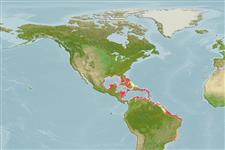>
Eupercaria/misc (Various families in series Eupercaria) >
Haemulidae (Grunts) > Haemulinae
Etymology: Anisotremus: Greek, anisos = unequal + Greek, trema, -atos = hole (Ref. 45335).
More on author: Linnaeus.
Environment: milieu / climate zone / depth range / distribution range
Ecologia
marino associati a barriera corallina; distribuzione batimetrica 2 - 70 m (Ref. 9710). Subtropical; 32°N - 33°S, 98°W - 34°W
Western Atlantic: Bermuda (introduced) and Florida, USA to Brazil, including the Gulf of Mexico and the Caribbean Sea (Ref. 9626).
Size / Peso / Age
Maturity: Lm ? range ? - ? cm
Max length : 40.6 cm TL maschio/sesso non determinato; (Ref. 40637); common length : 25.0 cm TL maschio/sesso non determinato; (Ref. 3798); peso massimo pubblicato: 930.00 g (Ref. 40637)
Spine dorsali (totale) : 12; Raggi dorsali molli (totale) : 16 - 18; Spine anali: 3; Raggi anali molli: 9. Body striped yellow and silvery blue; fins yellow, 2 black bars: one from nape through eye to mouth, another from origin of dorsal fin to base of pectoral fin. Only grunt fish in the Caribbean with two vertical black bars and yellow stripes. (Ref. 26938).
Maximum depth from Ref. 126840. Inhabits reefs and rocky bottoms. Feeds at night on mollusks, echinoderms, annelids, and crustaceans (Ref. 3798). Young pick parasites from the bodies of larger fishes (Ref. 5521). Young are popular aquarium fish (Ref. 7251). Marketed fresh (Ref. 3798). Has been reared in captivity (Ref. 35420).
Distinct pairing during breeding (Ref. 205).
Robins, C.R. and G.C. Ray, 1986. A field guide to Atlantic coast fishes of North America. Houghton Mifflin Company, Boston, U.S.A. 354 p. (Ref. 7251)
IUCN Red List Status (Ref. 130435: Version 2024-2)
Threat to humans
Reports of ciguatera poisoning (Ref. 30303)
Human uses
Pesca: scarso interesse commerciale; Pesce da pesca sportiva: si; Acquario: Acquari pubblici
Strumenti
Special reports
Download XML
Fonti Internet
Estimates based on models
Preferred temperature (Ref.
123201): 24.9 - 28.2, mean 27.4 °C (based on 791 cells).
Phylogenetic diversity index (Ref.
82804): PD
50 = 0.5039 [Uniqueness, from 0.5 = low to 2.0 = high].
Bayesian length-weight: a=0.01514 (0.00889 - 0.02578), b=3.05 (2.90 - 3.20), in cm total length, based on LWR estimates for this species & (Sub)family-body (Ref.
93245).
Trophic level (Ref.
69278): 3.6 ±0.5 se; based on diet studies.
Resilienza (Ref.
120179): Medio, tempo minimo di raddoppiamento della popolazione 1.4 - 4.4 anni (Preliminary K or Fecundity.).
Fishing Vulnerability (Ref.
59153): Low to moderate vulnerability (31 of 100).
Nutrients (Ref.
124155): Calcium = 22.6 [10.1, 62.8] mg/100g; Iron = 0.538 [0.258, 1.056] mg/100g; Protein = 19.6 [17.7, 21.7] %; Omega3 = 0.144 [0.066, 0.285] g/100g; Selenium = 13.1 [5.8, 27.3] μg/100g; VitaminA = 35.1 [9.5, 131.4] μg/100g; Zinc = 0.673 [0.404, 1.106] mg/100g (wet weight);
